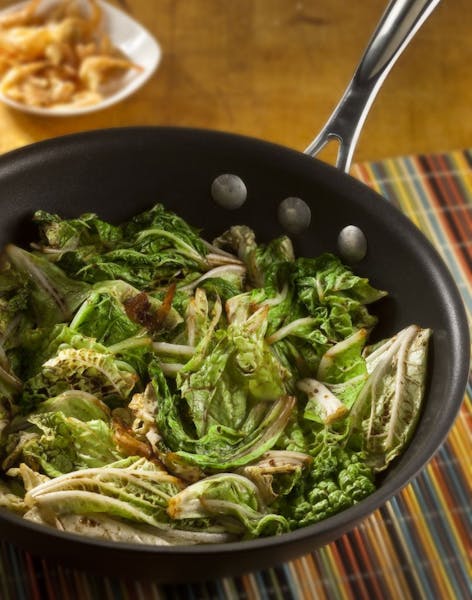Stir-fried lettuce may not seem like much, but the Cantonese term for lettuce, "sang choi," sounds like the Chinese words for "growing fortune." Expect to see this humble dish on many tables to usher in the Year of the Dragon, which started on Monday.
You can feel lucky year-round with greens cooked the Chinese way: fast, simply, deliciously. And don't forget the nutrients. Greens are good-for-you foods, especially when quick cooking locks in vitamins and nutrients.
Stir-frying is the technique that gives any greens, Eastern or Western, that sought-after Asian seared taste and aroma, says Grace Young, author of "Stir-Frying to the Sky's Edge" and other cookbooks.
"The magic is in the use of high heat, little oil and a few minutes' cooking," she says.
A range of Chinese greens
Bok choy: Mild, white-stalked vegetable. Use in salads, stir-fries, braises, soups. There are dozens of bok choy varieties, including baby bok choy (smaller, more delicate) and Shanghai bok choy (spoon-like pale-green stalks).
Chinese broccoli: Similar in appearance to broccoli rabe; has firm, asparaguslike stems prized for their crunchy texture, dark-green leaves and tight white flower buds. Sometimes blanched before being stir-fried; often paired with oyster sauce. Aka: Chinese kale, gai lan.
Chinese mustard cabbage: Long, broad leaves atop ribbed stalks are strongly flavored, bitter. Used fresh but usually seen salted and preserved. Used in soups, braises, stir-fries. Aka: gai choy or mustard greens.
Napa cabbage: Crinkly leaves, delicate taste. Very versatile: Use for dumplings, soups, stir-fries, braises; raw in salads, pickled as relishes. Aka: Chinese cabbage, Peking cabbage.
Water spinach: Hollow stems almost a foot long are a hallmark of this vegetable. Triangular green leaves. Use in stir-fries and soups.
Yu choi: Long stems, dark-green leaves, yellow flowers, tangy mustardlike flavor. Serve steamed, stir-fried or in soups. Aka: choi sum, choy sum, yow choy, yau choi, oil vegetable, Chinese flowering cabbage.
Steps to tasty greens
Grace Young offers these step-by-step tips for what to do with greens.
Buying: Choose flowering greens with tight buds. Open flowers signify aging produce. Avoid greens with yellow leaves or blemishes. Check stems and avoid any with holes. The smaller stem the better for Chinese broccoli. Wrap greens in paper towels and refrigerate in plastic bags up to three or four days. Water spinach and snow pea shoots deteriorate quickly; use that day, if possible.
Preparing: Get rid of all grit and sand. Cut the bottom 1/4 to 1/2 inch off the base, separate stalks and plunge into several changes of cold water. Dry washed greens thoroughly, using a salad spinner or kitchen towel. Wet greens will lower the wok temperature, turning stir-frying into stewing. Greens should feel almost dry to the touch before using.
Cooking: Heat a wok (a 14-inch, flat-bottomed, carbon-steel wok is ideal for home ranges) until it is hot enough to vaporize a bead of water within 1 or 2 seconds. High cooking heat demands a cooking oil that can withstand high temperatures. Use an oil such as peanut or canola. Do not use olive oil; it smokes at too low a temperature for proper stir-frying. Toasted sesame oil isn't for high-heat cooking but is a flavor accent.
After cooking, soak the wok in hot water for at least 5 minutes. Wash with a sponge; avoid soap to preserve the wok's patina. Dry on the stove over low heat 1 to 2 minutes.
